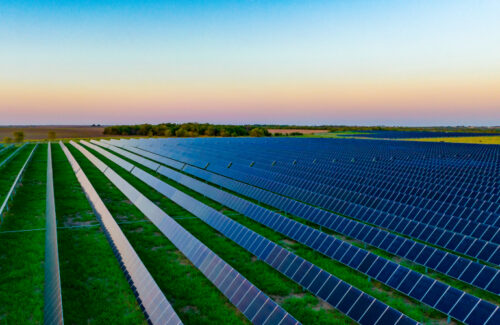
Credit: Lightsource bp
A review by the SUN DAY Campaign of data recently released by the Federal Energy Regulatory Commission (FERC) reveals that for the sixth month in a row, solar provided more new U.S. electrical generating capacity than any other energy source. In addition, solar as well as wind have grown significantly faster than earlier FERC forecasts.
Solar was 83.6% of new capacity in February
In its latest monthly “Energy Infrastructure Update” report (with data through February 29, 2024), FERC says 29 “units” of solar provided 1,043 megawatts (MW) of new domestic generating capacity or 83.64% of the total. Most of the balance (16.04%) was provided by the 200-MW Horizon Hill Wind Project in Logan County, Oklahoma. Natural gas generating capacity increased by only 4-MW.
For the first two months of this year, solar accounted for 78.50% (or 3,581-MW) of new generating capacity brought on-line while wind contributed another 20.34% (928-MW). Natural gas trailed with only 48-MW (1.05%) accompanied by 2-MW of oil and 3-MW of “other.”
Solar has now been the largest source of new generating capacity for six months straight: September 2023 – February 2024. For five of those six months, wind took second place with natural gas winning the No. 2 slot just once.
Solar is now in fourth place for share of U.S. generating capacity
The latest capacity additions have brought solar’s share of total available installed utility-scale (i.e., >1-MW) generating capacity up to 8.21%, surpassing that of hydropower (7.85%). Wind is currently at 11.77%. With the inclusion of biomass (1.15%) and geothermal (0.32%), renewables now claim a 29.30% share of total U.S. utility-scale generating capacity.
For perspective, just a year ago, solar’s share was 6.63% while wind and hydropower were 11.48% and 8.00% respectively. The mix of all renewables totaled 27.63%.
Installed utility-scale solar has now moved into fourth place — behind natural gas (43.76%), coal (15.99%) and wind — for its share of generating capacity after having recently surpassed that of nuclear power (8.00%).
Solar is likely to surpass the individual capacities of wind and coal within three years
FERC reports that “high probability” additions of solar between March 2024 and February 2027 total 87,749-MW – an amount more than triple the forecast net “high probability” additions for wind (23,874-MW), the second fastest growing resource.
FERC also foresees growth for hydropower (575-MW), geothermal (400-MW), and biomass (25-MW). The new 1,100-MW Vogtle-4 reactor in Georgia will increase nuclear capacity modestly while coal, natural gas, and oil are projected to contract by 21,487-MW, 3,131-MW, and 2,059-MW respectively.
If just FERC’s current “high probability” additions materialize, by March 1, 2027, solar will account for almost one-seventh (14.06%) of the nation’s installed utility-scale generating capacity. That would be greater than either coal (13.42%) or wind (12.76%) and substantially more than either nuclear power (7.57%) or hydropower (7.40%).
The mix of all renewables would account for 35.63% of total available installed utility-scale generating capacity — rapidly approaching that of natural gas (40.77%) — with solar and wind constituting more than three-quarters of the installed renewable energy capacity.
FERC’s “high probability” numbers for utility-scale solar as well as wind will almost certainly prove to be too conservative
In its December 2020 “Infrastructure” report, FERC projected that between January 2021 and December 2023, net “high probability” solar additions would total 36,691-MW while those for wind would reach 21,938-MW. In reality, solar additions during that three-year period totaled 45,908-MW – i.e., more than a quarter (25.12%) higher while actual wind capacity additions reached 29,378-MW or over a third greater (33.91%) than FERC’s forecast.
Moreover, FERC reports that there may actually be as much as 216,037-MW of net new solar additions in the current three-year pipeline in addition to 75,968-MW of new wind and 7,726-MW of new hydropower.
In addition, it should be noted that inasmuch as FERC only reports data for utility-scale facilities, its data do not reflect the capacity of distributed renewables, notably rooftop solar PV. According to the U.S. Energy Information Administration (EIA), small-scale solar PV is estimated to account for nearly a third of the nation’s electrical generation by solar.
This suggests that the total of distributed and utility-scale solar capacity combined is significantly more than the 8.21% FERC reported as solar’s share of total capacity at the end of February. It is perhaps closer to 12.0% and may be on track to approach or exceed 20.0% within three years.
That, in turn, could also bring the generating capacity provided by the mix of all renewables close to — or even surpass — that of natural gas within three years.
“Without question, solar is on a roll as it surpasses FERC’s expectations and leads all other energy sources in providing new generating capacity,” noted the SUN DAY Campaign’s executive director Ken Bossong. “Including distributed solar, the mix of all renewables is poised to surpass natural gas capacity within the next few years.”
News item from the SUN DAY Campaign


















